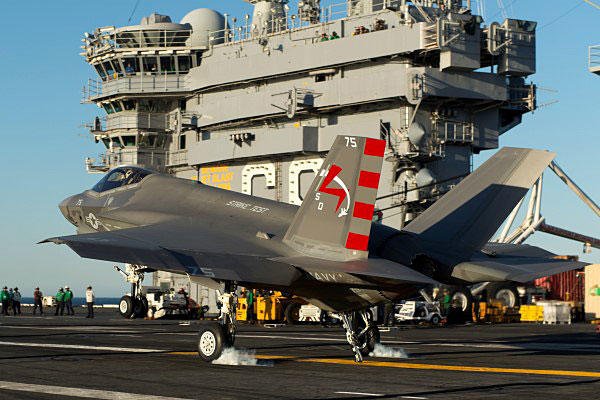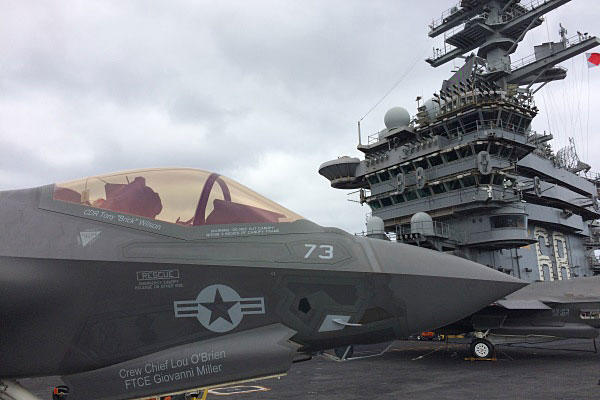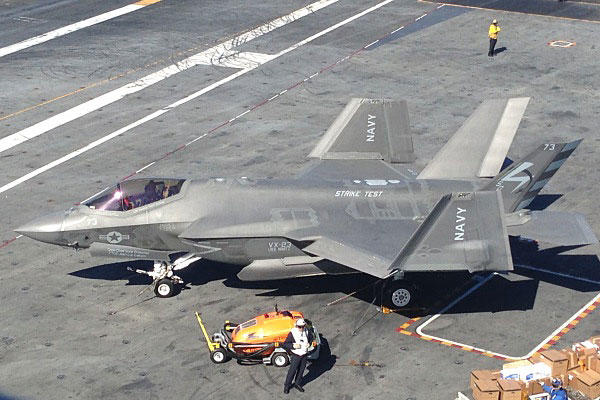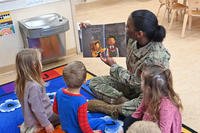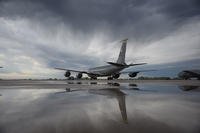ABOARD THE USS NIMITZ IN THE PACIFIC OCEAN -- With smoke rising from the deck of the carrier and moderate winds churning up the seas, the Navy's F-35C took off from the aircraft carrier Nimitz as part of a historic series of test flights marking a major milestone in the service's first carrier-launched stealth fighter.
Following the first landing of the F-35C on Nov. 3, test pilots have conducted more than 100 approaches, landings and takeoffs on the Nimitz's flight deck. Last week's successful landing offered both history and relief for a Joint Strike Fighter program that Pentagon leaders say will revolutionize airpower, but has also been plagued by countless delays and budget overruns.
The Navy's variant of the fifth-generation fighter is arguably the most complex because it must execute catapult shots and landings from the flight deck. And it's also the one facing the most questions as many defense analysts have questioned the Navy's commitment to the Joint Strike Fighter program.
The ongoing maneuvers on the Nimitz are part of a 14-day developmental test period designed to gather data and assess the F-35C's ability to achieve the proper "glide slope," handle catapult takeoffs, and land on the flight deck under a variety of wind conditions.
"If you look across the inventory at where we have stealth technology, it is all ground based. Now we have sea-based stealth technology. That provides us capabilities that we currently do not have," said Rear Adm. Dee Mewbourne, commander of Carrier Strike Group 11.
Navy leaders, pilots and engineers said the initial testing has gone well. Ultimately, the Navy and Marine Corps plan to acquire 680 F-35Cs and F-35Bs -- the Marine Corps' short-take-off-and-landing variant of the aircraft.
"Our job is to identify the issues and report on them. All the issues that we have been finding are very minor," said Navy Cmdr. Tony Wilson, an F-35C test pilot. "The main focus of the test has been catapult shots and landings. We did do shore-based testing to make sure we were ready to come out here. However, the big difference is you can't simulate rolling off the edge of an aircraft carrier when you are shore based."
Success Amidst Budget Problems
Successful test flights on the F-35C program could be seen as a welcome development for a program that experienced budget cutbacks earlier this year. The Navy's five-year budget plans outlined in the service's 2015 budget request cut the planned buy of F-35C aircraft almost in half, from 69 to 36.
Although service officials at the time said the numbers would be made up in future years, some observers questioned if the reduction indicated hesitations about the program overall.
A second round of developmental testing is slated for next summer to study the aircraft's ability to operate on a carrier while carrying weapons internally, Wilson said. A third period of testing with external weapons on board is also slated, all designed to bring the aircraft to operational status by 2018, Navy officials said.
"In this main round of testing, we're looking at the basic aircraft. We're looking at the approach and handling qualities. We're looking at high headwinds, low headwinds, crosswinds and a bunch of different wind variations as well," said Chris Karapostoles, an F-35C test pilot.
Being engineered for a carrier, the F-35C's 51-foot wingspan is larger than the Air Force's F-35A and Marine Corps' F-35B. An empty F-35C weighs 34,800 pounds, carries up to 19,000 pounds of fuel and 18,000 pounds of weapons. It is configured to fire two AIM-120C air-to-air missiles and two 2,000-pound guided bombs, or Joint Direct Attack Munitions. It can reach speeds up to Mach 1.6 and travel more than 1,200 nautical miles.
Landing a Stealth Fighter at Sea
As part of the testing, pilots practice maintaining their glide slope by watching a yellow light on the flight deck called the Fresnel Lens. It includes a vertical row of yellow lights between two horizontal rows of green lights. Using a series of lights and mirrors, a pilot's approach is reflected by the position of the yellow light in relation to the green lights above and below, displaying whether the aircraft is on the right "center line" or "glide slope," Karapostoles said.
"If he [the pilot] is on glide slope, he will see a centered amber ball in between the horizontal green lights. If he goes high on glide slope, he will see the ball rise above the green lights. If he goes below glide slope, he will see the ball fall below the green lights," he explained.
The F-35C is also engineered with a technology referred to as Delta Flight Path, a system that uses software to help the flight control computer automatically correct course and adjust the aircraft's flight path as needed.
"Instead of manually controlling thrust and pitch attitude, our flight control engineers have cut out the middle work so the flight path is controlled directly. It gives us spare capacity to monitor the other systems on the jet. We are landing the jet almost exactly where we want almost every time," said Cmdr. Christian Sewell, a F-35C test pilot.
Pilots try to land the F-35C in between the second and third of four cables arranged on the landing deck, Sewell explained.
In order to properly align for an approach to the flight deck about three-quarters of a mile away, pilots make a sharp, descending 180-degree turn to slow the aircraft and begin descending from about 600 feet, Wilson said.
"Once we arrive on center line and on glide slope, that is where the precision comes in because your runway is essentially moving sideways on you," he explained.
The testing is also assessing how the F-35C catapults off the deck. The steam catapult on board the Nimitz is thrusting the aircraft off the deck at a range of speeds in order to test the slowest and fastest potential takeoff speeds, said Lt. Eric Ryziu, catapult arresting gear officer.
Aircraft are able to reach speeds up to 160 knots in about 2.5 seconds as a result of being thrust forward by the steam catapult, which stretches about 300 feet. The steam catapult generates 520 PSI (pounds per square inch) of pressure pushing pistons forward. The pistons push cylinders connected to a shuttle attached to a launch bar, which pulls the aircraft forward, Ryziu explained.
-- Kris Osborn can be reached at kris.osborn@monster.com.
